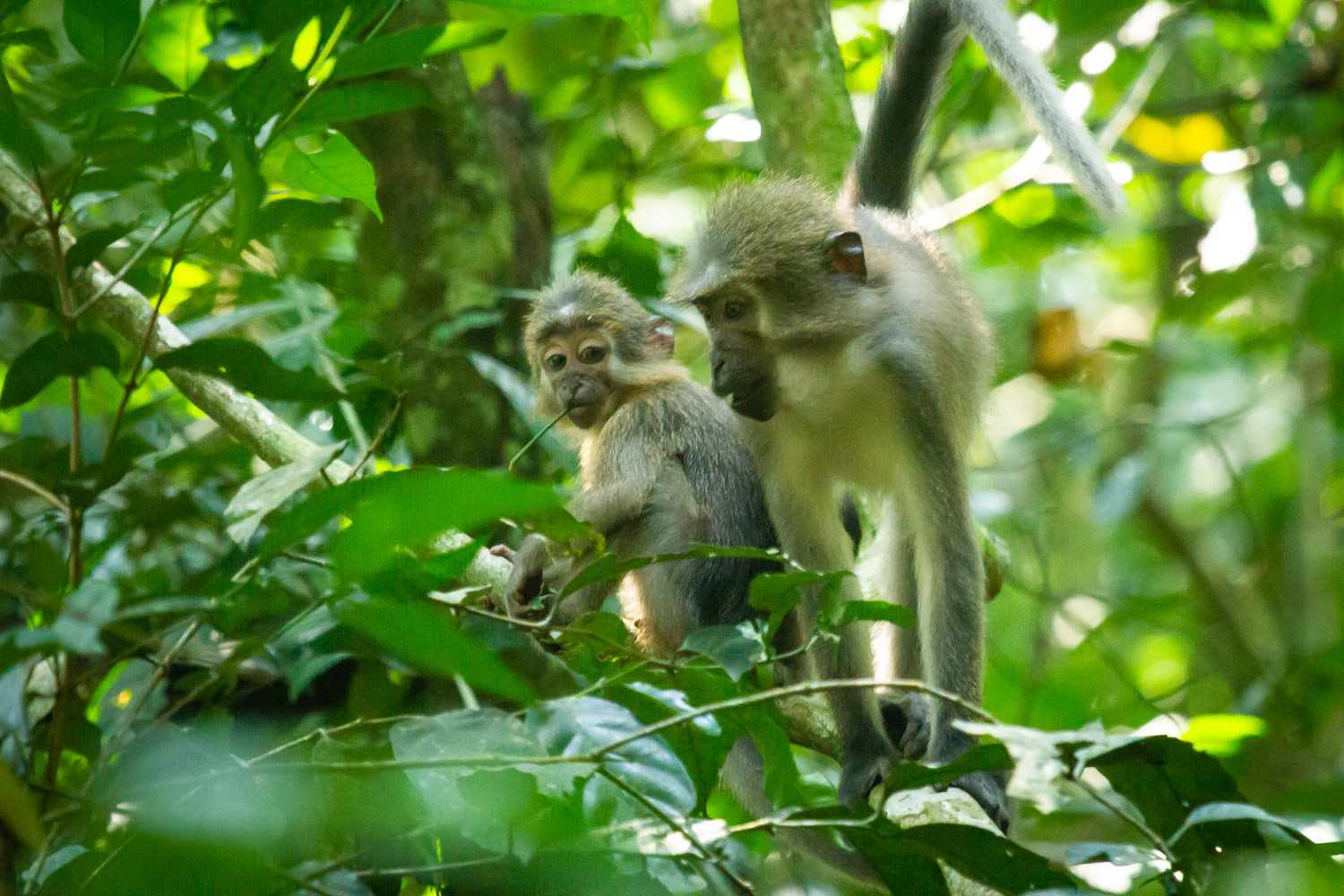
The Green Heart of Africa – Biodiversity Richness
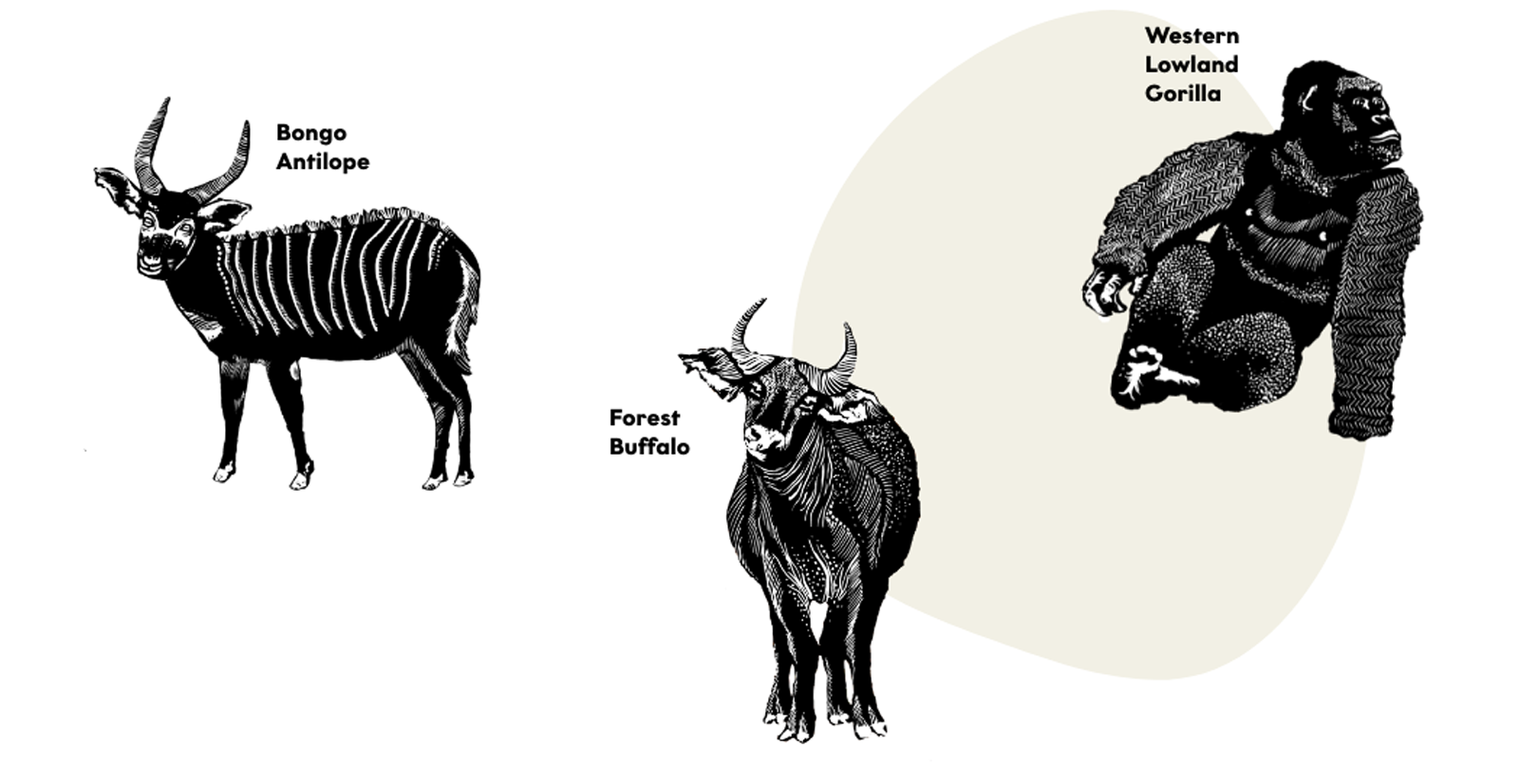
A Mosaic of Ecosystems
A mosaic of ecosystems, including rivers, streams, marshlands, typical grassy glades called bais, and marshes, supports viable populations of complete faunal and floral assemblages. These include top predators, rare and endangered species such as forest elephants, gorillas, and several antelope species such as the sitatunga and the emblematic bongo.
The Fascinating Gorilla
Those who have been lucky enough to see them in the wild are enriched with an unforgettable experience. The gorillas are after us humans the greatest apes. They live in strong social structures, and each individual has its own personality. All this exerts an enormous fascination. There are two species of gorillas worldwide: The Eastern Gorilla and the Western Gorilla, with two subspecies each. The gorillas of Dzanga-Sangha belong to the subspecies Western Lowland Gorilla (Gorilla gorilla gorilla).
During the day, the groups, which usually consist of a dominant silverback and several females with their offspring, roam in search of food in the rainforest and on natural forest clearings (bais). They cover a distance of about two kilometers while foraging, eating and resting, all in a slow pace. But when two groups meet, it becomes exciting: The two silverbacks try to impress each other – sometimes for several hours. Of course, the characteristic chest beating is also part of the repertoire. As a rule, these encounters end peacefully.
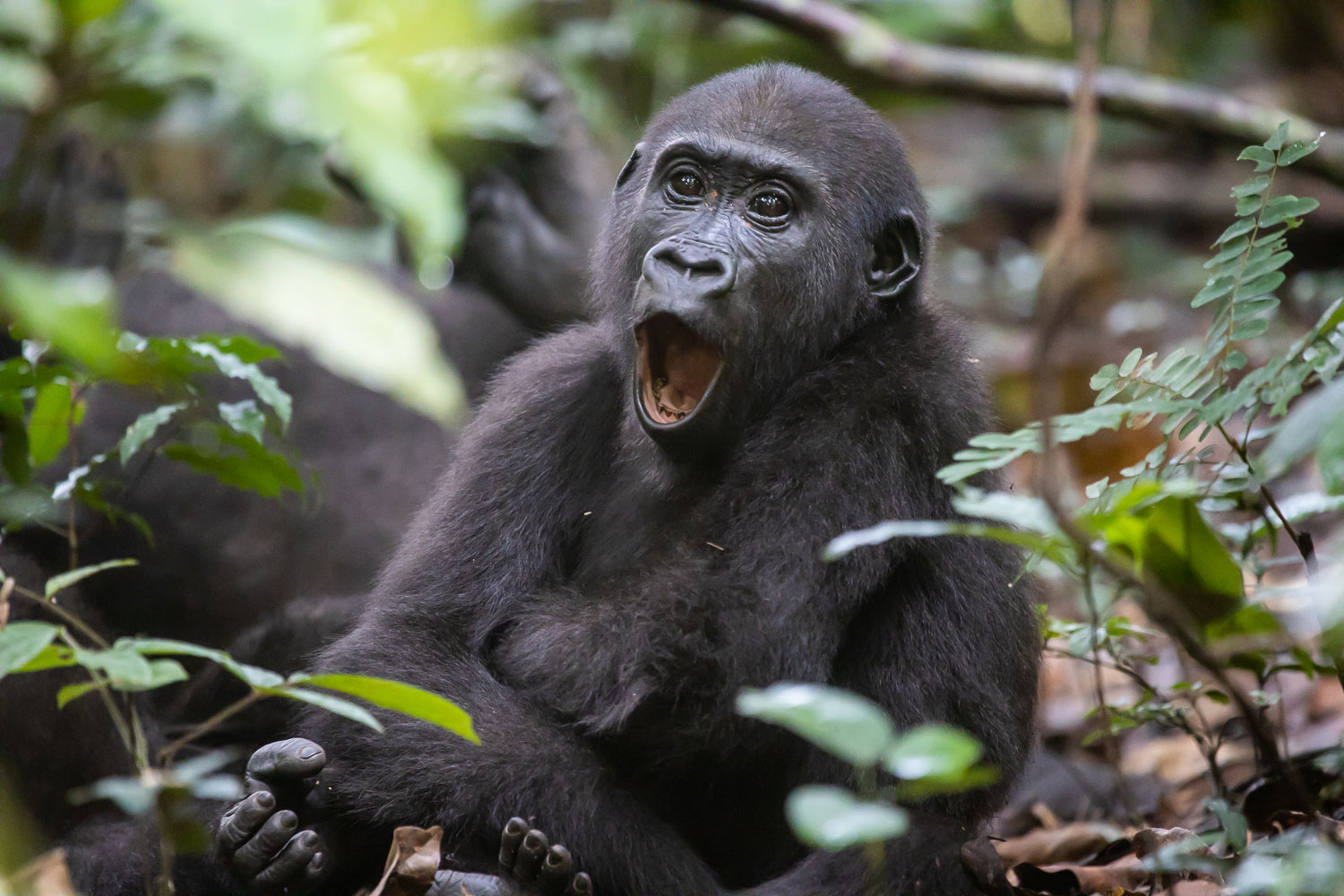
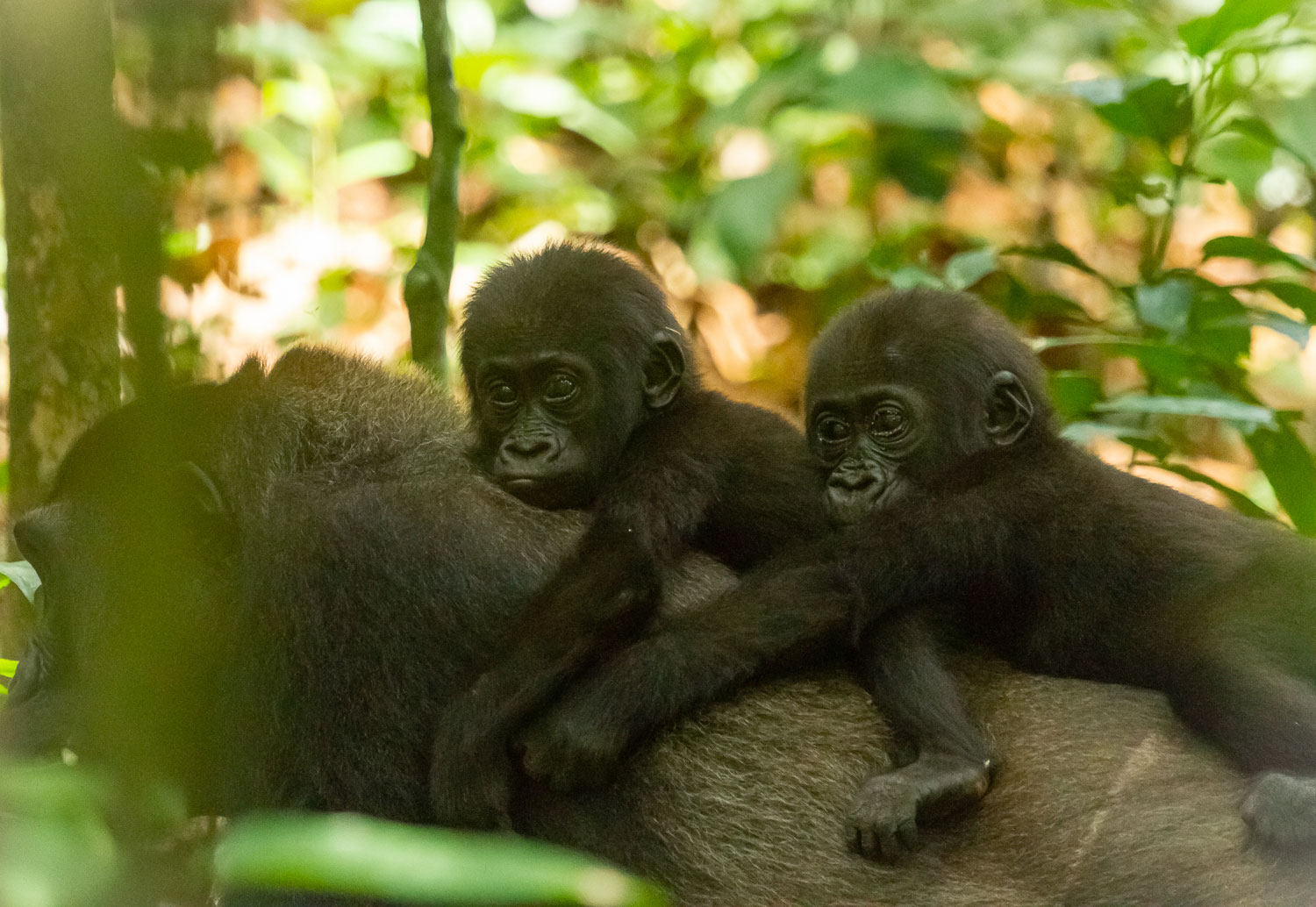
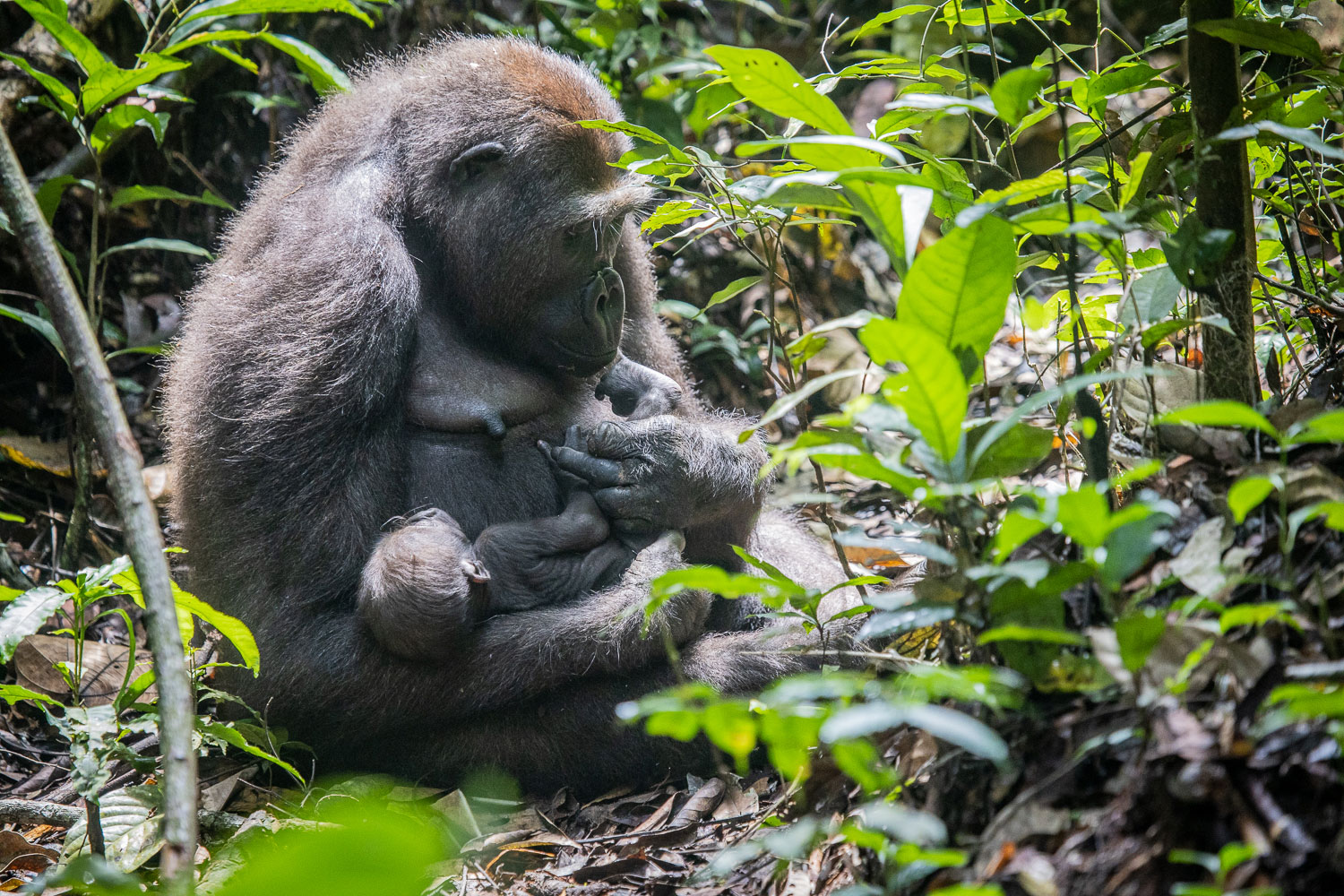
Threats and Vulnerability
Poaching, habitat loss, diseases and the consequences of climate change are all threats to the populations of western lowland gorilla. The greatest danger is poaching. Although the animals are protected, they are hunted or accidentally caught in poachers’ wire snares as “by-catch”. The result is the same: Their meat is sold and eaten. The effects of disease epidemics can also be devastating. Infections with the Ebola virus have cost the lives of countless apes in recent years. A worsening factor is the enormous pressure on gorilla habitats from settlements, roads and economic interests such as the timber industry. In the future, the consequences of climate change will aggravate this situation. Experts expect increasing drought, more forest fires and even a general decline in forest cover.
Estimates indicate that there are currently just fewer than 362,000 western lowland gorillas in the world. This may seem a lot at first glance, but it is misleading: This figure is a snapshot of a line whose trend is constantly pointing downwards. In the period between 2005 and 2013 alone, the number of western lowland gorillas decreased by almost a fifth! The subspecies is threatened with extinction.
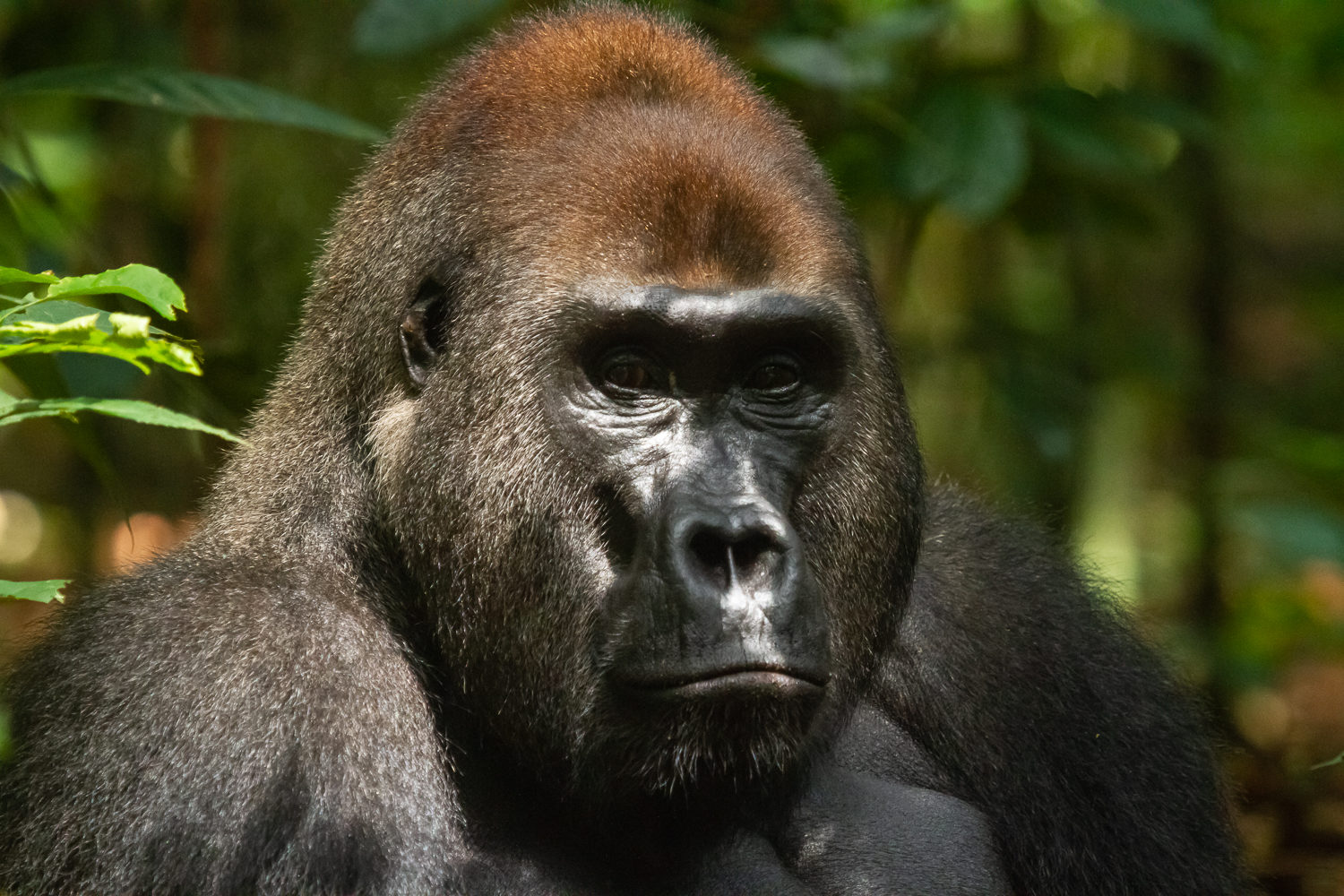
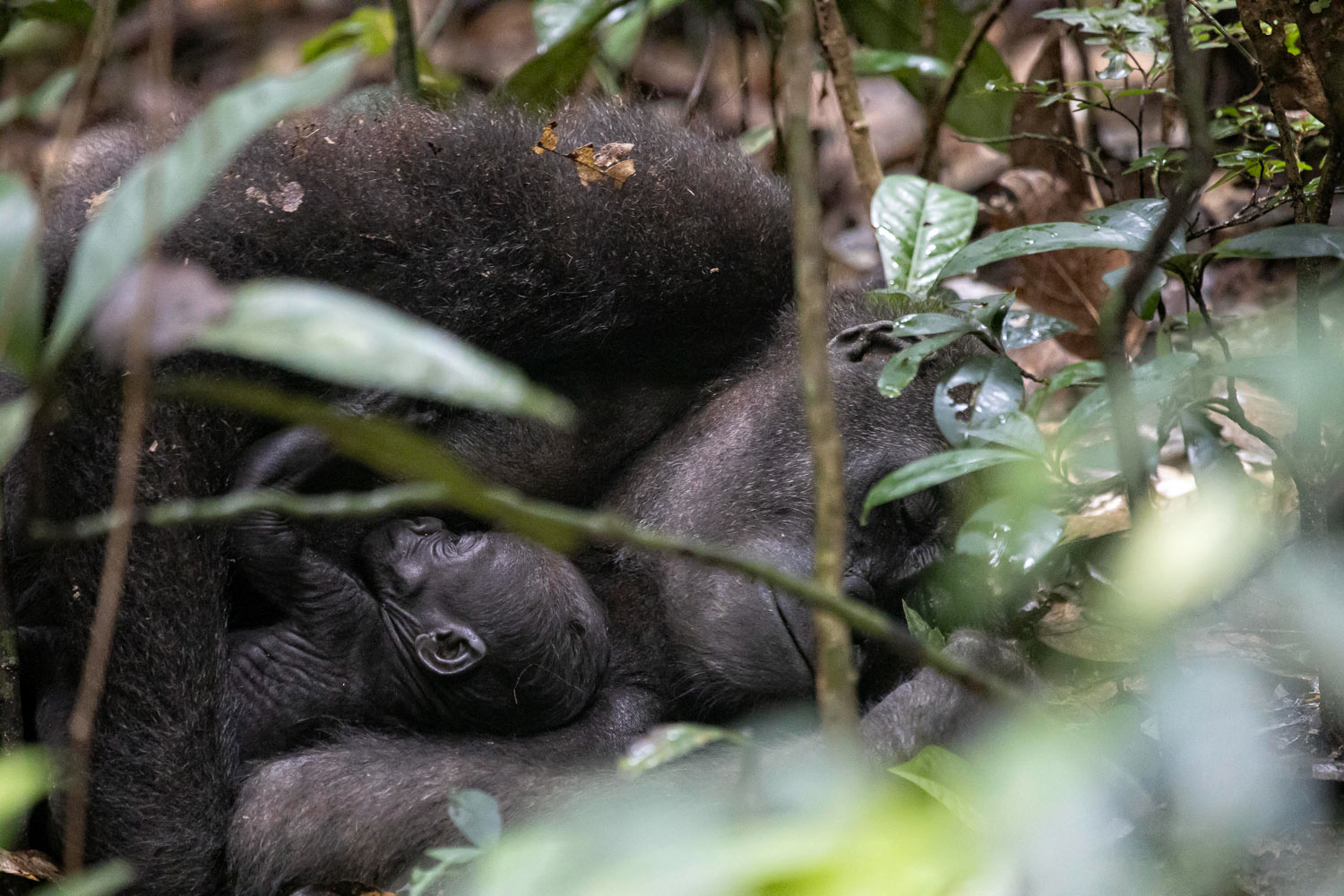
Gorillas in Dzanga-Sangha
According to the latest estimate, 2,215 individuals live in the Dzanga-Sangha Reserve. At present, there are three fully habituated gorilla groups, i.e. groups that are accustomed to the presence of humans. Visitors have the opportunity to visit and observe these animals in their natural habitat, accompanied by trained guides and local trackers. The Primate Habituation Program of Dzanga-Sangha is currently the most successful ecotourism and research program on the western lowland gorilla. The habituated gorillas are regularly visited by tourists and are the subject of many scientific articles and film documentaries.
The Fascinating Forest Elephant
They are intelligent, adaptive, social, empathetic and endowed with an incredible long-term memory. They are the African forest elephants. Like their larger relatives, the savannah elephants, they also have a wide range of means to communicate with each other. In addition to sounds, they exchange information by secreting substances, touching, using body language and even infrasound. Particularly intimate is the ritual mutual touch with the trunks with which elephants greet each other.

Forest elephants lead a hidden life in the dense jungle of the rainforests of Central and West Africa. In the shelter of the green canopy, they prefer to forage for fruit, but also eat leaves, shoots or even bark. They cover a great distance every day in search for food. In order to protect forest elephants, nature conservation strategies beyond the boundaries of protected areas and even national borders are therefore of the utmost importance.
Because forest elephants play an important role in the dispersal of seeds of many tree species, they are also called “forest architects”. They transport the seeds of the fruits they ate, defecating them over a radius of up to 57 kilometers, thus actively shaping their habitat and that of many other species.
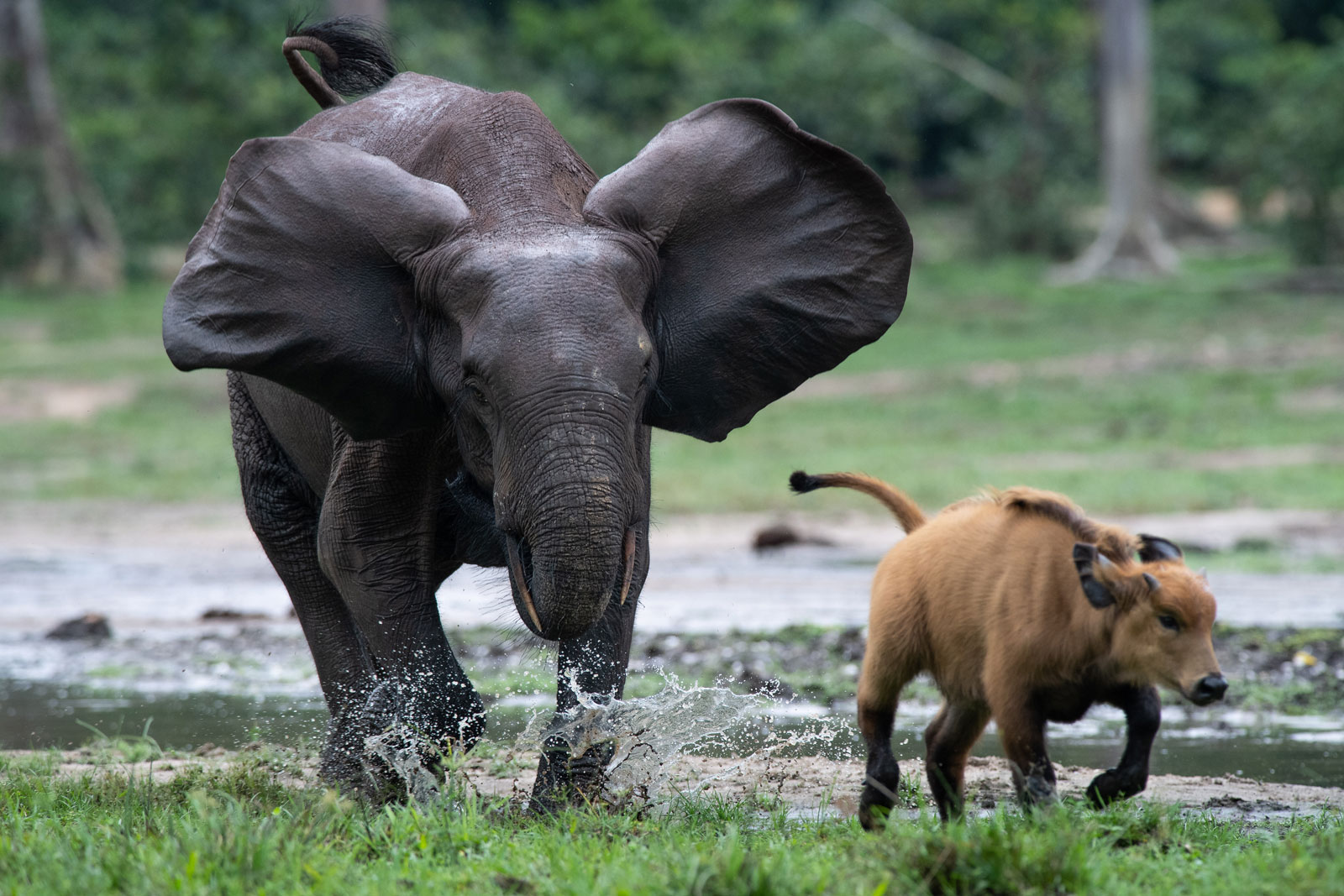
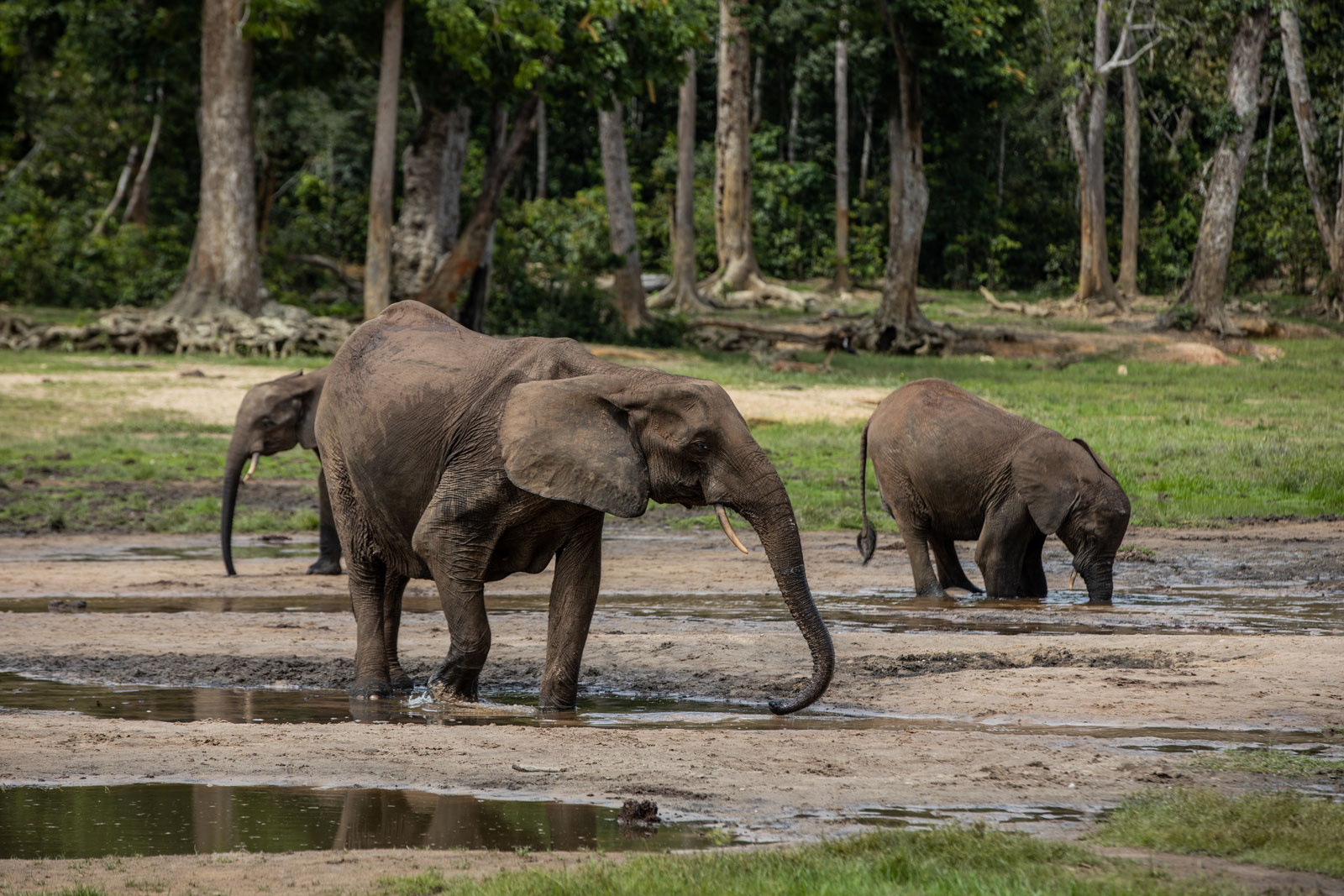
Threats and Vulnerability
From an estimated number of several millions before colonial times, the population of forest elephants has fallen at a worrying level of around 40,000 to 80,000 individuals today. In the course of only one decade, their number has collapsed by 70 percent and the forest elephant is on the verge of extinction. Hunting for ivory is the foremost cause of their disappearance. Nowhere in Africa is the ivory traffic more intense than in the Congo Basin. Criminal organizations of poachers bring the “white gold” to the Asian market and make immense profits. Forest elephant ivory is particularly in demand as it is more compact than the ivory of the savannah elephants and therefore more attractive.
Forest Elephants in Dzanga-Sangha
In Dzanga Sangha, visitors can experience a unique natural spectacle: On the Dzanga Bai, a huge natural clearing in the middle of the rainforest, more than 100 forest elephants come together at times. They visit the bai at regular intervals because the water there is particularly rich in vital minerals. From a large visitor platform, the elephants can be observed searching for the minerals at the water holes and in the ground, bathing in the mud, interacting and playing. A truly fascinating sight.
The Fascinating Bongo
If there was a beauty contest for antelopes, bongos would have the best prospect for one of the top places. Narrow white stripes adorn their bright red fur; on their head, along with their large ears sits a pair of elegantly twisted horns up to one meter long. The impressive males weigh up to 280 kilograms – more than five large sacks of cement. Only the legs seem a little too short. But the stocky physique is a perfect adaptation for the largest antelope species of the African rainforests.
And something else is special with the bongos: Both males and females have horns. The eland is the other only antelope with this characteristic.
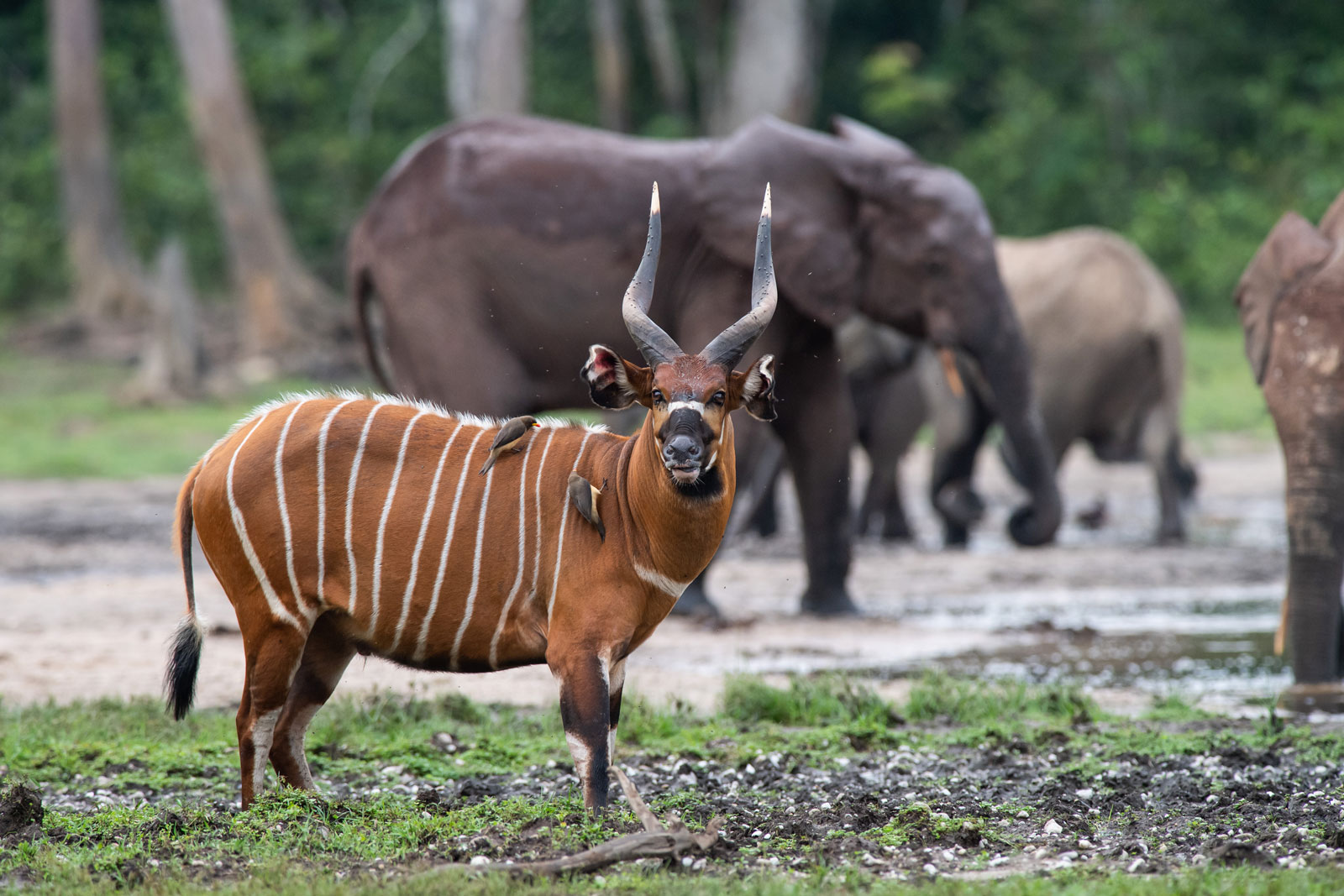
Threats and Vulnerability
Bongos occur naturally only in some areas of the equatorial forest zone of Africa. In addition, they are difficult to spot in the dense jungle as they are shy forest dwellers, predominantly active at dusk or at night. There is therefore no reliable estimate of their actual population size.
However, it is certain that the populations of the still relatively common western bongo (Tragelaphus eruycerus ssp. eurycerus), which occurs in Dzanga-Sangha, are declining. Habitat destruction, hunting and expanding settlements are the main causes. They are also attractive to trophy hunters because of their beautiful horns.
The second subspecies, the eastern bongo (Tragelaphus eruycerus ssp. isaaci), exists only in four small isolated populations in the mountainous regions of Kenya and is threatened with extinction.
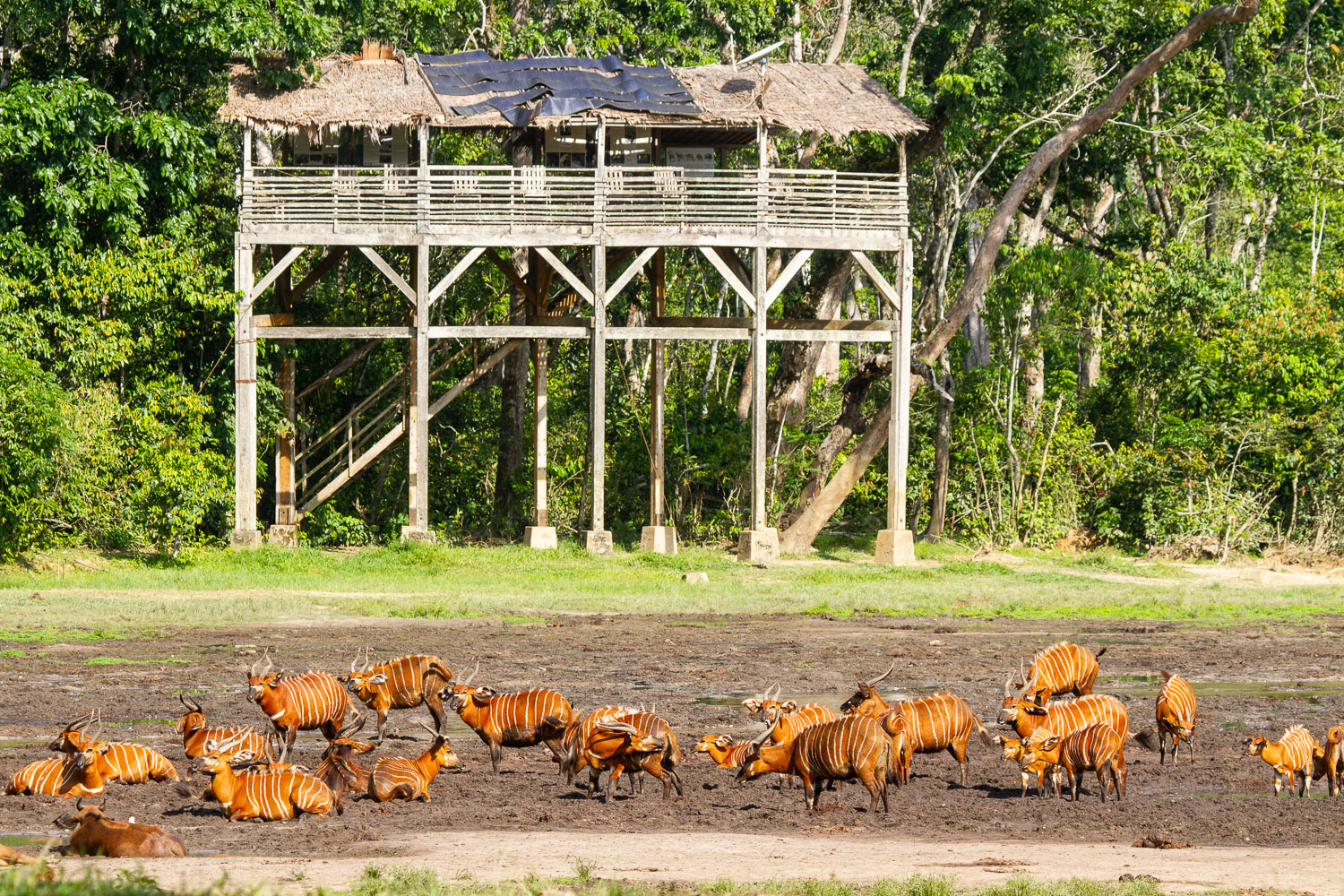
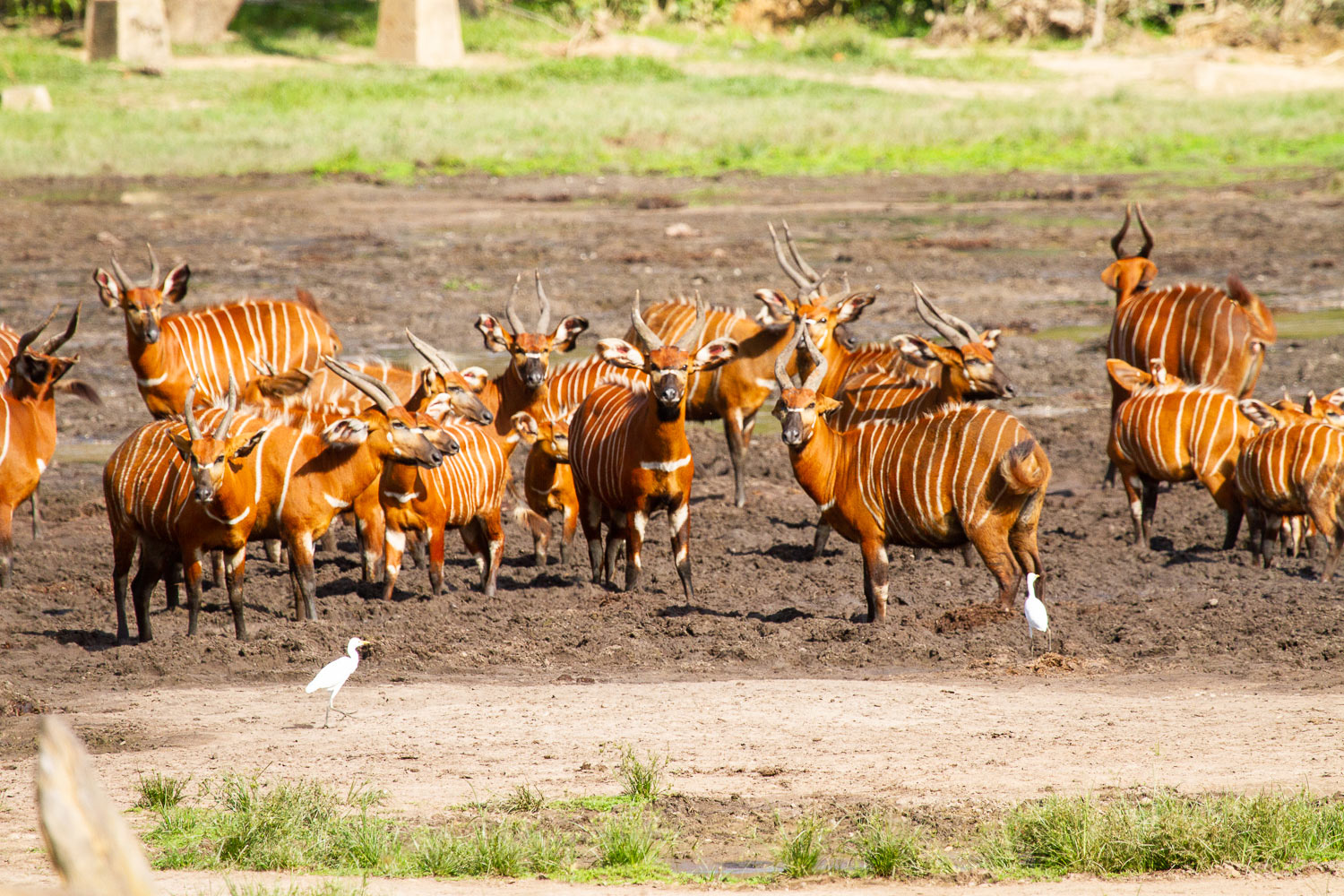
Bongos in Dzanga-Sangha
Although shy and rather active at dusk and at night, there is a great chance to see bongos in their habitat in Dzanga Sangha. As for many other species of the jungle, the natural forest clearings (bais) are also a magnet for bongos. They come because of the mineral water and the nutritious flowers and leaves, sedges, grasses and herbs. An important part of their social life also takes place in the clearings. By the way, the birth peak for bongos in Dzanga-Sangha occurs between June and August.
The Fascinating Agile Mangabey
Usually, they are more easily heard than seen. They are the agile mangabeys, large primates of a height up to 65 cm, belonging to the family of long-tailed monkeys. They only live in the rainforests north of the Congo River, mostly in inaccessible swampy forests – in other words, where we bipeds get to, if at all, only with the greatest effort. Since all members of a group, usually about 20 animals, permanently fight for food and mating partners, a daily routine with a lot of screaming and nagging is quite normal for agile mangabeys. But beware! If you hear a long sequence of high-pitched chuckles, it is an alarm call! A leopard might be approaching, a snake slithering on a branch or an eagle looking for prey …

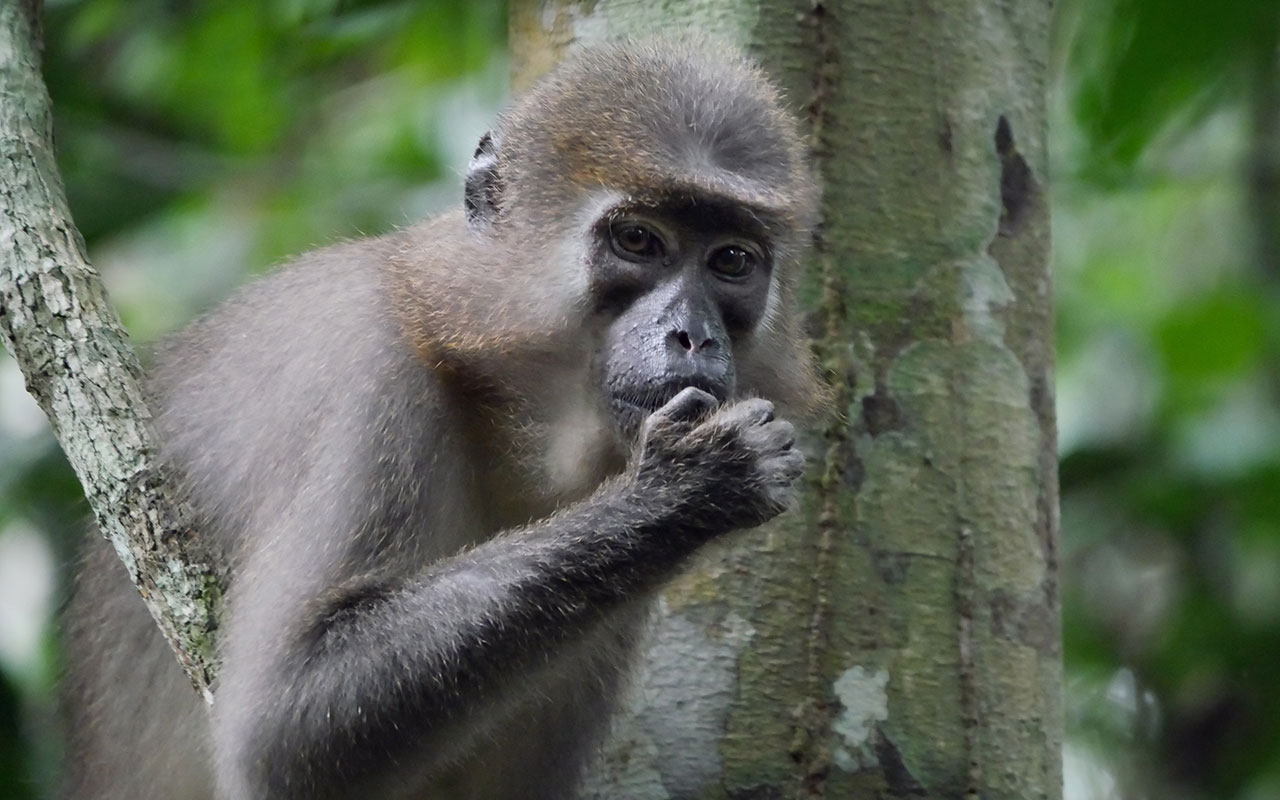
Once the danger is over and peace returns, the agile mangabeys resume their day-to-day activities, including foraging for food. They particularly love fruits, both ripe and unripe. But seeds, nuts, shoots, buds, insects and mushrooms also disappear in their mouths – everything the rainforest has to offer in terms of vegetarian food and bugs.
Threats and Vulnerability
The agile mangabeys are among those animal species of Central Africa about which we know very little. Therefore, it is difficult to a ascertain their conservation status. But the mere fact that they are endemic to the area north of the Congo River – i.e. only found here – is a justification for their protection. The loss of their habitat is a constant threat to the agile mangabeys as well as to all species of the Central African rainforests.

Agile Mangabeys in Dzanga-Sangha
Dzanga-Sangha offers a unique opportunity to observe agile mangabeys at close quarters, not far from the Bai Hokou Research Station. We are not talking of an average group of 20 animals, but more than 100, sometimes even up to 300, in the world’s only habituated group of this primate species. This means that the animals are used to the presence of humans, who have an opportunity to directly observe their family life. A visit to the agile mangabeys is definitely exciting and extremely entertaining!
The Fascinating African Forest Buffalo
Everyone is familiar with the image of the mighty African buffaloes wandering in large herds across Africa’s savannahs. But hardly anyone knows that there are also buffaloes in the rainforests of the Congo Basin. They are the home of the African forest buffalo, also known as the red buffalo because of its reddish fur. On one side of the “buffalo spectrum”, the enormous African buffalo has a body weight of up to 900 kilograms, forms herds of up to 20,000 animals and covers a territory of up to 1,000 km2. The numbers are all inferior with the forest buffalo: Its weight does not exceed 300 kilograms, making it only about a third of the size of the African buffalo, its herds are small, with 25 animals at the most, and 8 km2 are a sufficient territorial area. In addition to grasses, herbs and leaves found in forest clearings, the forest buffalo needs shade and constant access to water. All these can be found right here, in the rainforests of western and central Africa.

Threats and Vulnerability
We still know very little about the way of life of the shy forest buffalo, and about the exact number still living in the rainforests of the Congo basin. There is no accurate information available. However, we know that the population has continued to decline over the past decades. The destruction of the forests is as much a threat as illegal hunting, because there is a high demand for forest buffaloes for bushmeat.
African Forest Buffaloes in Dzanga-Sangha
Those who visit Dzanga-Sangha should not miss a detour to the large forest clearing (Dzanga Bai). The most conspicuous are the numerous forest elephants. The bongos are also an eye-catcher. But then, at third glance, if not before, the forest buffaloes attract our attention. They come here to graze, rest or take a mud bath in the heat. If you take a closer look, you will see an interesting detail: Unlike African buffaloes, the horns of the forest buffalo are not curved downwards and then hooking up sideways, but rise diagonally to the rear. Seen from the front, they look like two outwardly curved crescents. This shape is surely an advantage for a forest buffalo to make its way through the dense jungle!
Western Lowland Gorilla
The Fascinating Gorilla
Those who have been lucky enough to see them in the wild are enriched with an unforgettable experience. The gorillas are after us humans the greatest apes. They live in strong social structures, and each individual has its own personality. All this exerts an enormous fascination. There are two species of gorillas worldwide: The Eastern Gorilla and the Western Gorilla, with two subspecies each. The gorillas of Dzanga-Sangha belong to the subspecies Western Lowland Gorilla (Gorilla gorilla gorilla).
During the day, the groups, which usually consist of a dominant silverback and several females with their offspring, roam in search of food in the rainforest and on natural forest clearings (bais). They cover a distance of about two kilometers while foraging, eating and resting, all in a slow pace. But when two groups meet, it becomes exciting: The two silverbacks try to impress each other – sometimes for several hours. Of course, the characteristic chest beating is also part of the repertoire. As a rule, these encounters end peacefully.



Threats and Vulnerability
Poaching, habitat loss, diseases and the consequences of climate change are all threats to the populations of western lowland gorilla. The greatest danger is poaching. Although the animals are protected, they are hunted or accidentally caught in poachers’ wire snares as “by-catch”. The result is the same: Their meat is sold and eaten. The effects of disease epidemics can also be devastating. Infections with the Ebola virus have cost the lives of countless apes in recent years. A worsening factor is the enormous pressure on gorilla habitats from settlements, roads and economic interests such as the timber industry. In the future, the consequences of climate change will aggravate this situation. Experts expect increasing drought, more forest fires and even a general decline in forest cover.
Estimates indicate that there are currently just fewer than 362,000 western lowland gorillas in the world. This may seem a lot at first glance, but it is misleading: This figure is a snapshot of a line whose trend is constantly pointing downwards. In the period between 2005 and 2013 alone, the number of western lowland gorillas decreased by almost a fifth! The subspecies is threatened with extinction.


Gorillas in Dzanga-Sangha
According to the latest estimate, 2,215 individuals live in the Dzanga-Sangha Reserve. At present, there are three fully habituated gorilla groups, i.e. groups that are accustomed to the presence of humans. Visitors have the opportunity to visit and observe these animals in their natural habitat, accompanied by trained guides and local trackers. The Primate Habituation Program of Dzanga-Sangha is currently the most successful ecotourism and research program on the western lowland gorilla. The habituated gorillas are regularly visited by tourists and are the subject of many scientific articles and film documentaries.
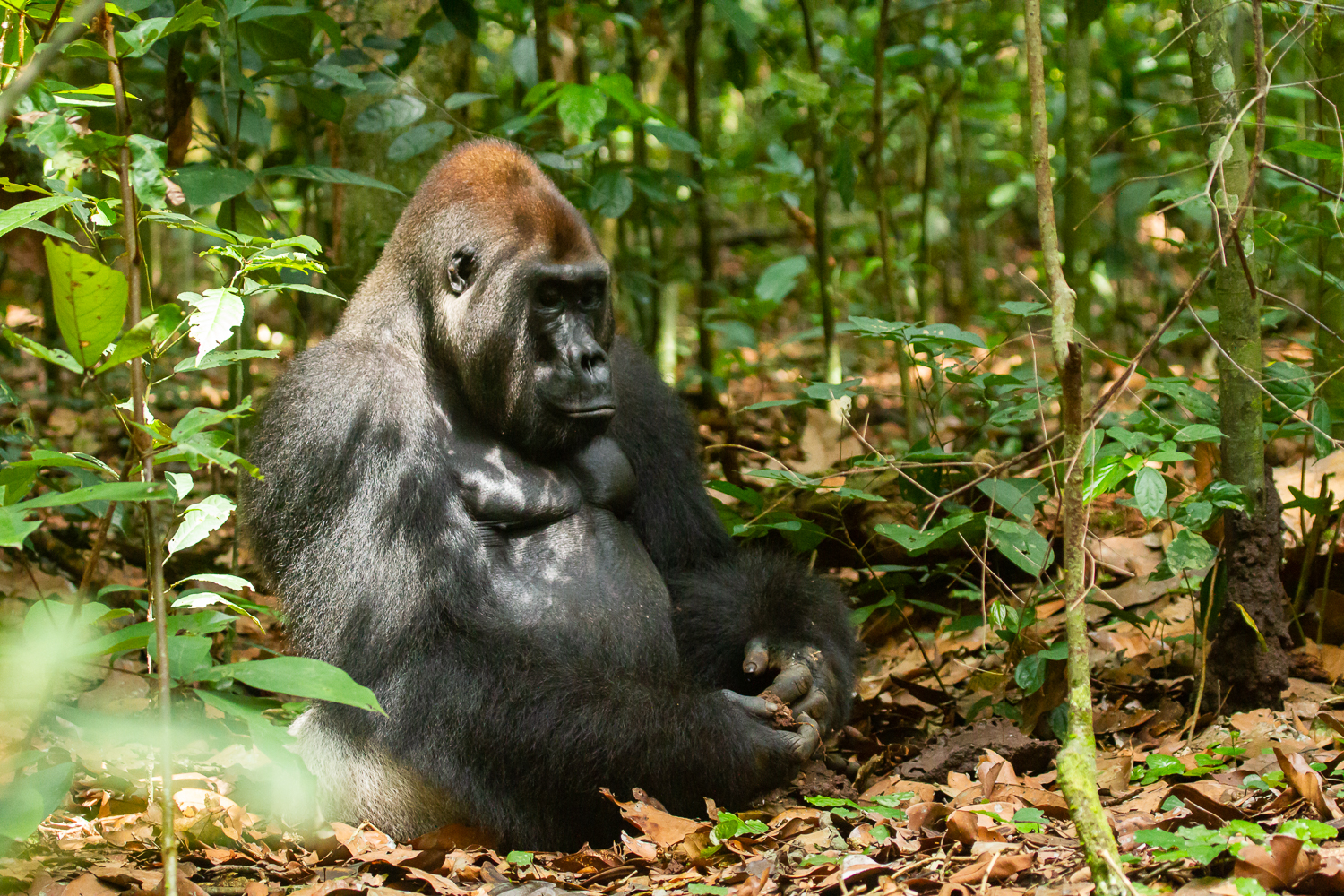
Forest Elephant
The Fascinating Forest Elephant
They are intelligent, adaptive, social, empathetic and endowed with an incredible long-term memory. They are the African forest elephants. Like their larger relatives, the savannah elephants, they also have a wide range of means to communicate with each other. In addition to sounds, they exchange information by secreting substances, touching, using body language and even infrasound. Particularly intimate is the ritual mutual touch with the trunks with which elephants greet each other.

Forest elephants lead a hidden life in the dense jungle of the rainforests of Central and West Africa. In the shelter of the green canopy, they prefer to forage for fruit, but also eat leaves, shoots or even bark. They cover a great distance every day in search for food. In order to protect forest elephants, nature conservation strategies beyond the boundaries of protected areas and even national borders are therefore of the utmost importance.
Because forest elephants play an important role in the dispersal of seeds of many tree species, they are also called “forest architects”. They transport the seeds of the fruits they ate, defecating them over a radius of up to 57 kilometers, thus actively shaping their habitat and that of many other species.


Threats and Vulnerability
From an estimated number of several millions before colonial times, the population of forest elephants has fallen at a worrying level of around 40,000 to 80,000 individuals today. In the course of only one decade, their number has collapsed by 70 percent and the forest elephant is on the verge of extinction. Hunting for ivory is the foremost cause of their disappearance. Nowhere in Africa is the ivory traffic more intense than in the Congo Basin. Criminal organizations of poachers bring the “white gold” to the Asian market and make immense profits. Forest elephant ivory is particularly in demand as it is more compact than the ivory of the savannah elephants and therefore more attractive.
Forest Elephants in Dzanga-Sangha
In Dzanga Sangha, visitors can experience a unique natural spectacle: On the Dzanga Bai, a huge natural clearing in the middle of the rainforest, more than 100 forest elephants come together at times. They visit the bai at regular intervals because the water there is particularly rich in vital minerals. From a large visitor platform, the elephants can be observed searching for the minerals at the water holes and in the ground, bathing in the mud, interacting and playing. A truly fascinating sight.
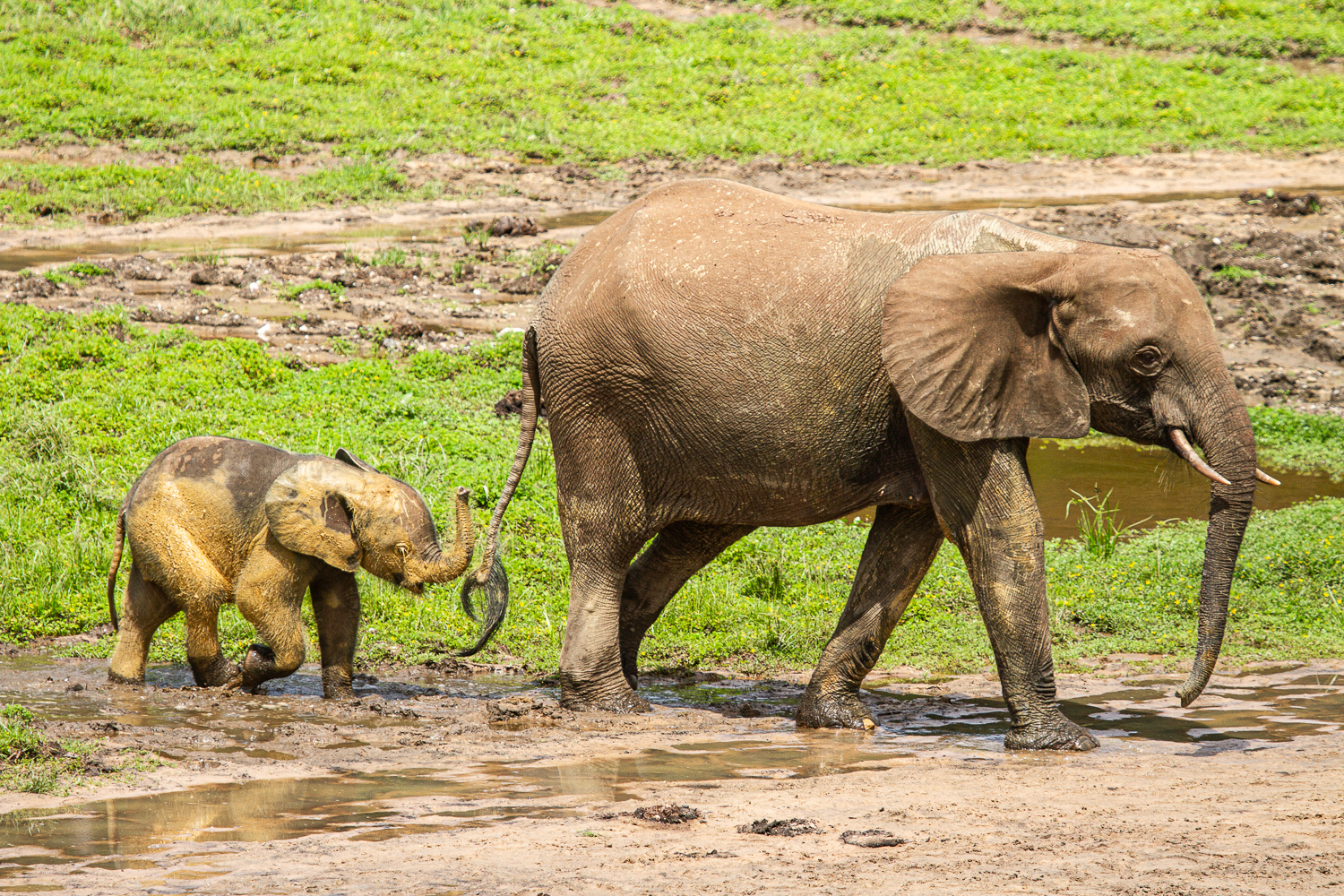
Bongo Antelope
The Fascinating Bongo
If there was a beauty contest for antelopes, bongos would have the best prospect for one of the top places. Narrow white stripes adorn their bright red fur; on their head, along with their large ears sits a pair of elegantly twisted horns up to one meter long. The impressive males weigh up to 280 kilograms – more than five large sacks of cement. Only the legs seem a little too short. But the stocky physique is a perfect adaptation for the largest antelope species of the African rainforests.
And something else is special with the bongos: Both males and females have horns. The eland is the other only antelope with this characteristic.

Threats and Vulnerability
Bongos occur naturally only in some areas of the equatorial forest zone of Africa. In addition, they are difficult to spot in the dense jungle as they are shy forest dwellers, predominantly active at dusk or at night. There is therefore no reliable estimate of their actual population size.
However, it is certain that the populations of the still relatively common western bongo (Tragelaphus eruycerus ssp. eurycerus), which occurs in Dzanga-Sangha, are declining. Habitat destruction, hunting and expanding settlements are the main causes. They are also attractive to trophy hunters because of their beautiful horns.
The second subspecies, the eastern bongo (Tragelaphus eruycerus ssp. isaaci), exists only in four small isolated populations in the mountainous regions of Kenya and is threatened with extinction.


Bongos in Dzanga-Sangha
Although shy and rather active at dusk and at night, there is a great chance to see bongos in their habitat in Dzanga Sangha. As for many other species of the jungle, the natural forest clearings (bais) are also a magnet for bongos. They come because of the mineral water and the nutritious flowers and leaves, sedges, grasses and herbs. An important part of their social life also takes place in the clearings. By the way, the birth peak for bongos in Dzanga-Sangha occurs between June and August.

Agile Mangabey
The Fascinating Agile Mangabey
Usually, they are more easily heard than seen. They are the agile mangabeys, large primates of a height up to 65 cm, belonging to the family of long-tailed monkeys. They only live in the rainforests north of the Congo River, mostly in inaccessible swampy forests – in other words, where we bipeds get to, if at all, only with the greatest effort. Since all members of a group, usually about 20 animals, permanently fight for food and mating partners, a daily routine with a lot of screaming and nagging is quite normal for agile mangabeys. But beware! If you hear a long sequence of high-pitched chuckles, it is an alarm call! A leopard might be approaching, a snake slithering on a branch or an eagle looking for prey …


Once the danger is over and peace returns, the agile mangabeys resume their day-to-day activities, including foraging for food. They particularly love fruits, both ripe and unripe. But seeds, nuts, shoots, buds, insects and mushrooms also disappear in their mouths – everything the rainforest has to offer in terms of vegetarian food and bugs.
Threats and Vulnerability
The agile mangabeys are among those animal species of Central Africa about which we know very little. Therefore, it is difficult to a ascertain their conservation status. But the mere fact that they are endemic to the area north of the Congo River – i.e. only found here – is a justification for their protection. The loss of their habitat is a constant threat to the agile mangabeys as well as to all species of the Central African rainforests.

Agile Mangabeys in Dzanga-Sangha
Dzanga-Sangha offers a unique opportunity to observe agile mangabeys at close quarters, not far from the Bai Hokou Research Station. We are not talking of an average group of 20 animals, but more than 100, sometimes even up to 300, in the world’s only habituated group of this primate species. This means that the animals are used to the presence of humans, who have an opportunity to directly observe their family life. A visit to the agile mangabeys is definitely exciting and extremely entertaining!

Forest Buffalo
The Fascinating African Forest Buffalo
Everyone is familiar with the image of the mighty African buffaloes wandering in large herds across Africa’s savannahs. But hardly anyone knows that there are also buffaloes in the rainforests of the Congo Basin. They are the home of the African forest buffalo, also known as the red buffalo because of its reddish fur. On one side of the “buffalo spectrum”, the enormous African buffalo has a body weight of up to 900 kilograms, forms herds of up to 20,000 animals and covers a territory of up to 1,000 km2. The numbers are all inferior with the forest buffalo: Its weight does not exceed 300 kilograms, making it only about a third of the size of the African buffalo, its herds are small, with 25 animals at the most, and 8 km2 are a sufficient territorial area. In addition to grasses, herbs and leaves found in forest clearings, the forest buffalo needs shade and constant access to water. All these can be found right here, in the rainforests of western and central Africa.

Threats and Vulnerability
We still know very little about the way of life of the shy forest buffalo, and about the exact number still living in the rainforests of the Congo basin. There is no accurate information available. However, we know that the population has continued to decline over the past decades. The destruction of the forests is as much a threat as illegal hunting, because there is a high demand for forest buffaloes for bushmeat.
African Forest Buffaloes in Dzanga-Sangha
Those who visit Dzanga-Sangha should not miss a detour to the large forest clearing (Dzanga Bai). The most conspicuous are the numerous forest elephants. The bongos are also an eye-catcher. But then, at third glance, if not before, the forest buffaloes attract our attention. They come here to graze, rest or take a mud bath in the heat. If you take a closer look, you will see an interesting detail: Unlike African buffaloes, the horns of the forest buffalo are not curved downwards and then hooking up sideways, but rise diagonally to the rear. Seen from the front, they look like two outwardly curved crescents. This shape is surely an advantage for a forest buffalo to make its way through the dense jungle!
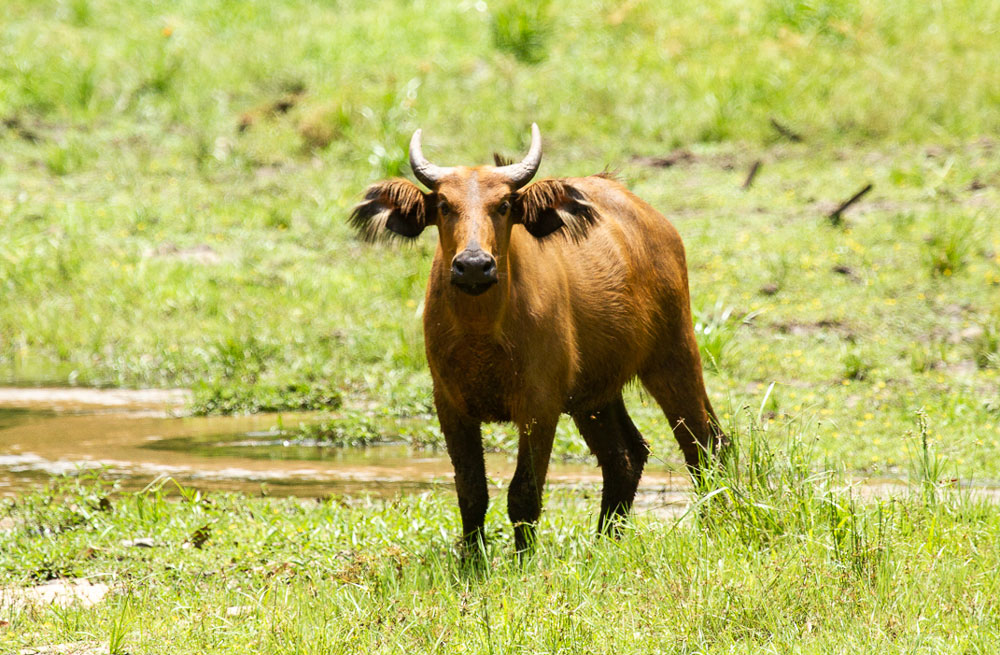
Remaining Threats despite the Protected Area Status
The value of the DSPA was recognized through the creation of the Dzanga-Sangha Protected Area Complex in 1990 and subsequently by its designation by UNESCO as a World Heritage Site in 2012. Despite its status as a protected area, Dzanga-Sangha is not safe from all threats.
Risks
The risks include the excessive exploitation of natural resources (mining, non-timber forest products, hunting of wild animals) caused by population growth and economic interests. This is being compounded by economic crises, instability, and accelerated unemployment in the CAR.
Unrest and Lack of Judicial Means in the CAR
In addition, the military and political unrest of 2012-2013 had an impact and led to the proliferation of weapons of war used for poaching. Finally, the judiciary system does not have the means and suitable premises to arrest criminals.
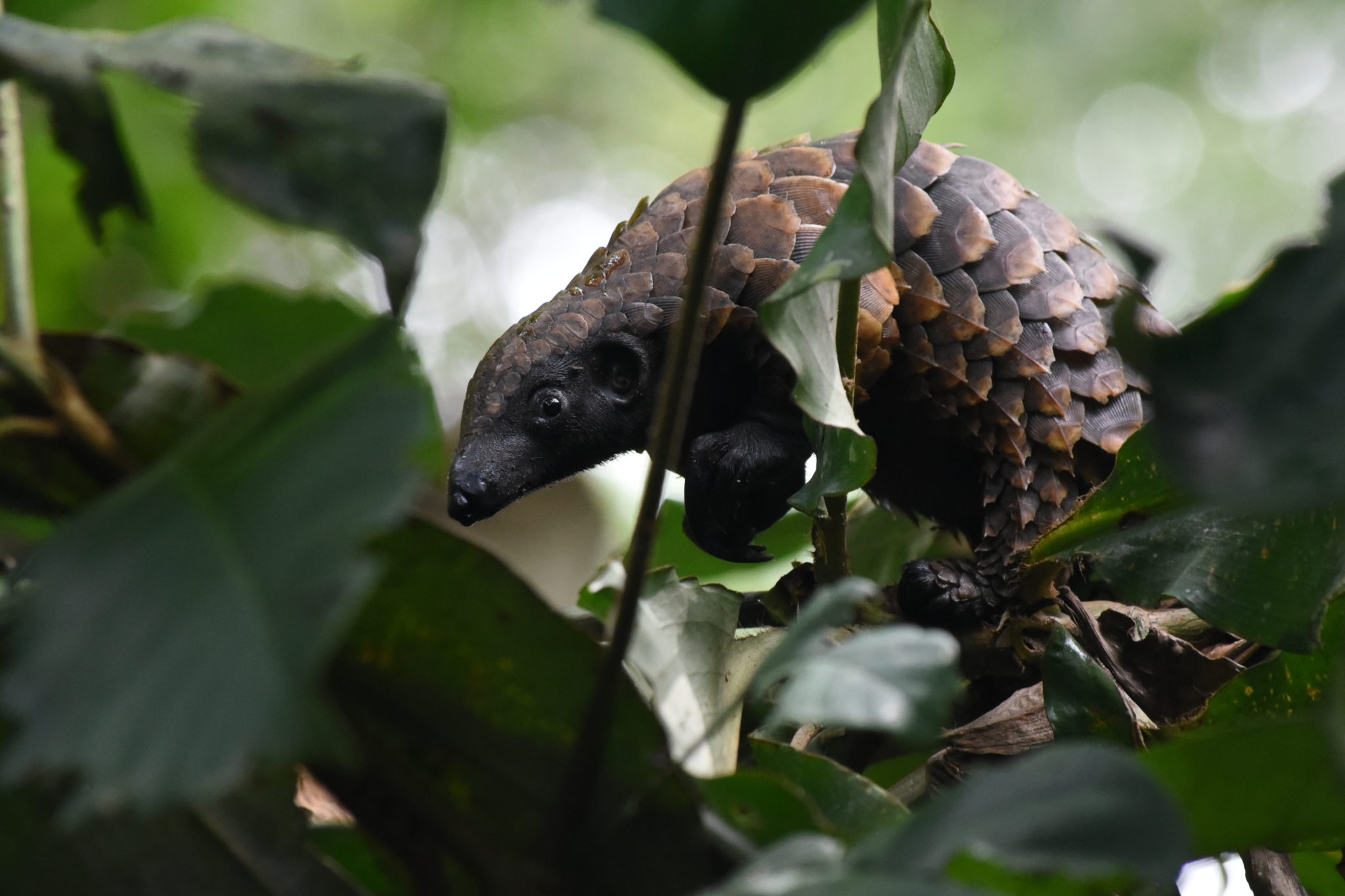

Direct Threats to the Biodiversity Values of this Protected Area.
Relentless Exploitation of Meat and Fish
Virtually all species are affected. The growing demand for bushmeat comes from distant urban areas where bushmeat is affordable to a growing population. The decrease of transportation costs linked to the opening of rainforests is an aggravating factor. Furthermore, unsustainable fishing methods cause a decline in stocks of many species which have no opportunity to recover.
Poaching for Ivory
The worldwide illegal trade in ivory is responsible for the sharp decline in elephant populations in Africa.
Habitat Destruction (Mining, Unsustainable Logging, Agriculture)
Population growth goes hand in hand with a rising demand for more land. This applies mostly to agricultural lands and the exploitation of natural resources. The habitat of many rare species is lost due to unsustainable land development. Since 2014, two companies have each been granted a logging and administrative permit. Logging by the two companies will be completed by 2020. At that point, their concession permit can be extended or renewed.
Communicable Diseases between Humans and Animals
Humans penetrate ever further into protected habitats. Wild species are thus confronted with germs unknown to their immune systems.
Such diseases, which can be transmitted from humans to animals through direct contact or through food, water and the environment, are generally referred to as “zoonoses”.
The primary objective of conservation efforts is to mitigate the direct threats mentioned above, in particular poaching for bushmeat and ivory as well as the destruction of habitats.